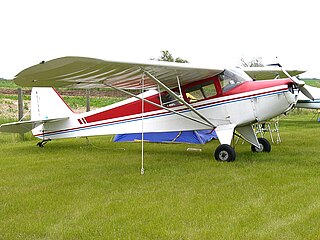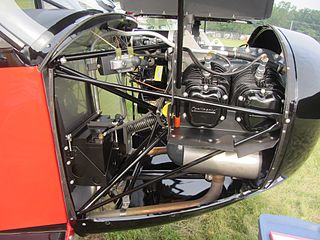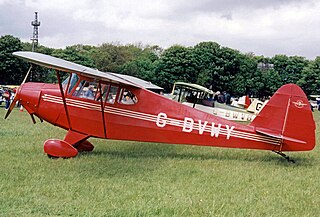
The ERCO Ercoupe is an American low-wing monoplane aircraft that was first flown in 1937. It was originally manufactured by the Engineering and Research Corporation (ERCO) shortly before World War II; several other manufacturers continued its production after the war. The final model, the Mooney M-10, first flew in 1968 and the last model year was 1970. It was designed to be the safest fixed-wing aircraft that aerospace engineering could provide at the time, and the type continues to enjoy a faithful following.

The Piper J-3 Cub is an American light aircraft that was built between 1938 and 1947 by Piper Aircraft. The aircraft has a simple, lightweight design which gives it good low-speed handling properties and short-field performance. The Cub is Piper Aircraft's second most-produced model after the PA-28 Cherokee series with over 20,000 built in the United States. Its simplicity, affordability and popularity invokes comparisons to the Ford Model T automobile.

The Continental O-170 engine is the collective military designation for a family of small aircraft engines, known under the company designation of A50, A65, A75 and A80. The line was designed and built by Continental Motors commencing in the 1940s. It was employed as the powerplant for civil and military light aircraft.

Taylorcraft Aviation is an American airplane manufacturer that has been producing aircraft for more than 70 years in several locations.

The Taylorcraft L-2 Grasshopper is an American observation and liaison aircraft built by Taylorcraft for the United States Army Air Forces in World War II.

The Piper J-4 Cub Coupe is a two place side-by-side version of the Piper J-3 that was built between 1938 and 1942 by Piper Aircraft. It was Piper's first model with side-by-side seating.

The Interstate Cadet is an American two-seat tandem, high wing, single-engine monoplane light aircraft. Around 320 of these aircraft were produced between the years 1941 and 1942 by the Interstate Aircraft and Engineering Corporation based in El Segundo, California. The construction techniques employed were a welded steel tube fuselage, wood (spruce) wing structure with metal ribs, and fabric covering, all of which were fairly standard in the 1940s.

The Continental O-190 is a series of engines made by Continental Motors beginning in the 1940s. Of flat-four configuration, the engines produced 75 hp (56 kW) or 85 hp (63 kW) respectively.

The Aeronca Model 50 Chief is an American light plane of the late 1930s. Consumer demand for more comfort, longer range and better instrumentation resulted in its development in 1938, powered by a 50-horsepower (37-kilowatt) Continental, Franklin or Lycoming engine. A 65-horsepower (48-kilowatt) Continental engine powered the Model 65 Super Chief, which was also built in a flight trainer version, the Model TC-65 Defender, with its rear seat positioned nine inches higher than the front for better visibility.

The Aeronca Model 7 Champion, commonly known as the "Champ", or "Airknocker", is a single-engine light airplane with a high wing, generally configured with fixed conventional landing gear and tandem seating for two occupants.

The Franklin O-150 was an American air-cooled aircraft engine of the late 1930s. The engine was of four-cylinder, horizontally-opposed layout and displaced 150 cu in (2 L). The power output was nominally 40 hp (30 kW).
The Franklin O-175 was an American air-cooled aircraft engine of the 1940s. The engine was of horizontally-opposed four-cylinder and displaced 175 cu in (2.9 L). The power output was nominally 80 hp (60 kW). A later variant was designated O-180, despite sharing the same displacement.

The Commonwealth Skyranger, first produced as the Rearwin Skyranger, was the last design of Rearwin Aircraft before the company was purchased by a new owner and renamed Commonwealth Aircraft. It was a side-by-side, two-seat, high-wing taildragger.

The Funk Model B is a 1930s American two-seat cabin monoplane designed by Howard and Joe Funk. Originally built by the Akron Aircraft Company later renamed Funk Aircraft Company.

The Porterfield Collegiate is an American-built two-seat training and touring monoplane built by the Porterfield Aircraft Corporation of Kansas City.

The Lycoming O-145 is a family of small, low-horsepower, four-cylinder, air-cooled engines. It was Lycoming Engines' first horizontally opposed aircraft engine and was produced from 1938 until the late 1940s. The family includes the reduction-geared GO-145. The O-145 received its Approved Type Certificate on 13 Jun 1938.

The Stits SA-3A Playboy is a single seat, strut-braced low-wing monoplane that was designed by Ray Stits for amateur construction. The aircraft was designed and the prototype was completed in a three-month period during 1952. The design went on to become one of the most influential in the post-war boom in aircraft homebuilding.

The Taylorcraft Model D is a light aircraft of the US manufacturer Taylorcraft Aviation from the early 1940s.

The Aeronca K series, Aeronca Chief, Aeronca Super Chief, Aeronca Tandem, Aeronca Scout, Aeronca Sea Scout, Aeronca Champion and Aeronca Defender were a family of American high-winged light touring aircraft, designed and built starting in the late 1930s by Aeronca Aircraft.





















